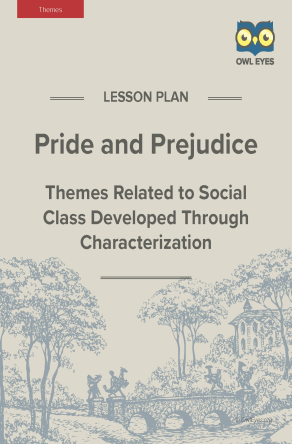Pride and Prejudice Themes Lesson Plan
- 24 pages
- Subject: Character Analysis, Historical Context, Themes, Lesson Plans and Educational Resources
- Common Core Standards: RL.9-10.1, RL.9-10.2, RL.9-10.3
- Grade Levels: 9, 10, 11, 12
Additional Pride and Prejudice Resources
Product Description
Themes Related to Social Class Developed Through Characterization
This lesson plan focuses on identifying themes related to social class as they are introduced through three major characters (Elizabeth, Mr. Bingley, and Mr. Darcy) in Pride and Prejudice. Students will determine the social class of the characters, describe their personal traits, and examine their behavior in several chapters from the beginning of the novel. From their study, students will identify major themes introduced in the novel, explain how they are developed through characterization, and support their interpretations with textual details. Upon completing this lesson plan, students will be better able to describe the influence of social class in Pride and Prejudice.
Skills: close reading, drawing inferences from the text, supporting interpretations of character and theme with textual details
Learning Objectives: By the end of this lesson plan, students will be able to
- analyze the role of wealth, gender, and family lineage in the English class structure.
- describe several characters as individuals and as members of a particular social class.
- identify themes related to social class by interpreting characters’ language and behavior in various chapters in the novel.
- support their interpretation of theme and characterization with specific details from the text.
About This Document
Owl Eyes lesson plans have been developed to meet the demanding needs of today’s educational environment and bridge the gap between online learning and in-class instruction. The main components of each plan include the following:
- An introduction to the text
- A step-by-step guide to lesson procedure
- Previous and following lesson synopses for preparation and extension ideas
- A collection of handouts and worksheets complete with answer keys
Each of these comprehensive, 60-minute plans focus on promoting meaningful interaction, analytical skills, and student-centered activities, drawing from the Common Core Standards for English Language Arts and the expertise of classroom teachers.
Introduction to the Lesson
Pride and Prejudice, published in 1813, is arguably Jane Austen’s most famous novel, and one of the most enduring works of literature in the English canon.
While creating the classic love story of the strong-willed, outspoken Elizabeth Bennet and the wealthy, arrogant Mr. Darcy, Austen also examines the influence of social class in shaping personal character and relationships. Austen’s narrative voice is heard throughout the novel, often witty and satirical, as she presents readers with a cast of colorful characters living in England’s regency society, all of whom reflect the era and reveal in one way or another the intrinsic strengths and weaknesses in human nature.
The influence of the prevailing social structure is introduced immediately in Pride and Prejudice with the arrival of Charles Bingley in rural Hertfordshire. When the unattached Mr. Bingley, who is as handsome and friendly as he is rich, rents the Netherfield Park estate, mothers compete to present their marriageable daughters as possible wives for him. No mother is as desperate to secure a match as Mrs. Bennet, who has five daughters to marry off—Jane, Elizabeth, Mary, Kitty, and Lydia. Mr. Bennet comes from a long line of landed gentry, but his daughters can’t inherit Longbourn, his estate, because it is entailed by law and tradition to a male relative. The five young women must find husbands to support them; otherwise, they’ll be financially destitute after their father dies. Complicating their marriage prospects is that their position in society has been compromised by Mr. Bennet’s having married beneath his social class. Mrs. Bennet’s boorish manners reflect poorly on the family, making the Bennets seem more middle-class than members of the landed gentry.
As Mrs. Bennet pushes her daughters to pursue Bingley, Elizabeth meets the snobbish Mr. Darcy, and their class-conscious, conflict-ridden relationship begins. Through the deep and genuine love for each other they ultimately achieve, Austen suggests that character counts more than social class in defining one’s individuality and that happiness is found through honest introspection and a willingness to grow and change in personal relationships.
List of Handouts and Worksheets
Class Structure in Regency England (1790-1830)
Identifying and Describing Three Major Characters
Analyzing Three Major Characters (Chapter III)
Analyzing Three Major Characters (Chapter VI)
Analyzing Three Major Characters (Chapter XI)
Identifying Themes Through Characterization







